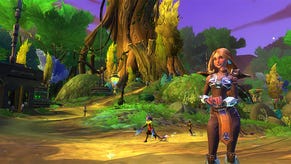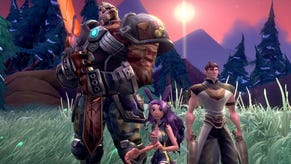WildStar PC Review: This Planet Revolves Around the Fun
The early levels of WildStar obscure a fun and robust MMO. Carbine Studios shows off nine years of development in one big launch.
This article first appeared on USgamer, a partner publication of VG247. Some content, such as this article, has been migrated to VG247 for posterity after USgamer's closure - but it has not been edited or further vetted by the VG247 team.
I'll be honest, WildStar starts off really slow.
I'm an advocate for every minute of our entertainment being good. I dislike the idea of "it gets good after the first few hours" or "you have to watch for X episodes before it gets good." That's the art's problem, not the viewer's. If the first hour of the game doesn't draw you in, that's the game's fault. You and the entertainment didn't meet eye-to-eye. You can put down the controller and never look back.
Despite that, I must admit that WildStar doesn't really open up until around levels 10-15.
That's when the game takes off the training wheels and really digs deep into all the systems it has available. By time you hit that magic number, WildStar has thrown a ton of stuff at you and it's still overwhelming, even though Carbine Studios has parsed it out slowly over the course of 15 levels. The slow start is because there's so much to see and do in WildStar; without a measured pace, you run the risk of information overload. Even with that pace, you'll feel overwhelmed at times.
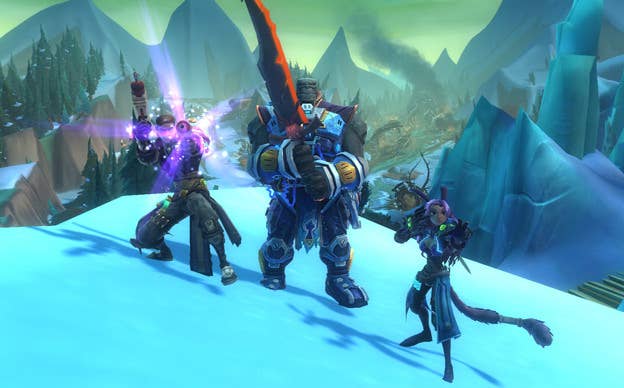
You have to dig into WildStar, finding new things to do as you move deeper and deeper. Carbine Studios, a team started by former Blizzard employees, has had nine years to figure out what works and doesn't in MMOs. WildStar is them turning in their homework.
Like most games since World of Warcraft first set up shop, WildStar is a tale of two factions: the Exiles and the Dominion. The Exiles are nominally the good guys; the Rebel Alliance-esque faction that just wants to be free from the Dominion, who believe it's their right to rule the galaxy. On the Exiles side, you have the Humans, the bulky Granok, the cyborg undead Mordesh, and the cute-bait treehugging Aurin. The Dominion is comprised of the Cassians (read: Humans), the robotic Merchari, the demonic Draken, and the crazy fuzzball Chua. Both factions converge on the planet Nexus, a newly-discovered planet that seemingly belonged to the galaxy's first race, the Eldan. That's where the game takes place.
Once you've picked your side, you have to pick you class; WildStar's classes are skewed funhouse versions of the MMO classes you've become accustomed to. The Holy Trinity - Tank, Healer, and DPS - still exist in WildStar and each of the classes can fill two of the roles. The Warrior is the warrior: big sword, tank or dps. The Stalker is the Rogue analog, but they can stealth even in combat and their secondary role has them as highly-evasive dodge tanks. The Esper is your classic healer, using powerful illusions to heal allies and damage foes.

After those three classes, the simple comparisons start to break down and WildStar gets odd. The Spellsinger is a ranged damage dealer and healer; the class has high mobility and can teleport around the battlefield after a fashion. (I don't think I'll ever get used to the idea of healing bullets.) The Engineer is a pet class that can tank for friends and hurt mobs, commanding a posse of robots to control the battlefield. Finally, the Medic uses resonators and specially-placed fields to heal or harm. These latter three classes are the ones that will give players new experiences, while the first three classes provide more familiar play.
But wait, there's more! You also have to pick your Path, a WildStar-exclusive concept that's based around the overall playstyles of MMO players. The idea is you gain experience and other perks for playing the game how you want to play it. The Scientist path comes with a handy scanbot to research artifacts and hack terminals out in Nexus. The Settler path lets players build improvements around the world, including aid stations, hospitals, and trading posts. The Soldier path is focused on combat above all else, with extra weapons and missions that let you stomp out waves of foes. The Explorer path is all about finding new areas and discovering the highs and lows of Nexus.
I chose the Explorer path for my main character, though I tried a bit of the other three. My path gave me that extra push to play the game, that extra something to do while I was traversing the world and killing each area's requisite number of Dominion soldiers. The Explorer path shows you where points of interest are, but it's up to you to find them. Sometimes, I ignored my main quests completely just trying to map all the points of interest in a certain area. Hell, I spent a good two hours in one zone just wandering around doing Explorer missions. And since that's the kind of thing I like to do normally, it worked. I get cool stuff for being me, instead of feeling forced into something. The Path system could backfire if a player doesn't want to participate in any of the four Paths, but I find that unlikely the first time around.

All four Paths intersect if you're playing with a solid group. An Explorer may find a new path that leads to a secret door that a Scientist can unlock, which leads to a cache of items for the Soldier. Together, the Paths build an extra metagame around WildStar. You could completely ignore them - if you did so, you'd probably never even know all these secrets are there - but they give you added incentive to not only explore Nexus, but to do so with friends.
Combat is rather important because it's still what you're going to be doing 80 percent of the time. Combat is WildStar is action-oriented, like Guild Wars 2 or Tera; there's lots of movement and no auto-attack. Your class abilities are your only attacks. Every ability has a telegraph, meaning the game shows you the area where an ability will hit. Attacks, heals, and buffs, all have color-coded telegraphs (red is bad, green is good). Line up the ability's telegraphs with your target and it'll hit. Telegraphs even fill with their respective color to tell you when an ability will go off. Most player abilities have simple telegraphs cones, squares, and straight lines. This extends to the enemies... in the beginning.
See once you get to level 15 and beyond, Carbine assumes that you understand telegraphs and staying out of the fire. So it starts to ramp things up. The telegraph patterns get more complex. There are less gaps at different timed intervals. When you go up against dungeon and raid bosses, the patterns are frankly insane, requiring precision movement to stay alive. It's a level of complexity that can only come from completely committing to the telegraph system as a visual representation of incoming damage or healing.

In addition, interrupts are a huge part of the game's combat. If you interrupt an enemy while their telepgrah is filling up, they'll become stunned, giving you a short time to deal extra damage. As you level up, the game introduces interrupt armor, meaning you have to interrupt a target a few times in succession to get to the creamy extra damage center. This requires working in tandem with other players, timing your interrupts.
All this means that WildStar is a very high-movement MMO where communication is key. The game does not play around. The dungeons are hard for new players and a poor party member can bring down the entire crew. I have wiped far more times in WildStar than I have in other games; I consider myself to be a veteran player, but this game made me rethink that at times. Carbine is selling the game as an MMO for hardcore players with difficult and complex encounters. From what I've played, they've delivered. That's not completely a plus for me as I've moved on from my hardcore raider days, but I can see the draw for a certain demographic of players.
The telegraphs also extend into PVP, which can take place in various modes: there's normal open-world PVP, arena battles for 2v2, 3v3, and 5v5 combat, 10v10 battlegrounds, and the unique Warplots feature. Warplots allows guilds to purchase what amounts to a player-created raid fortresses, fill them with traps and bosses, and then join in an all-out war against another guild. The objective of each group is to surmount the obstacles and destroy the other team's generators. Both sides get XP, loot, and items to place in their housing plots for their troubles.
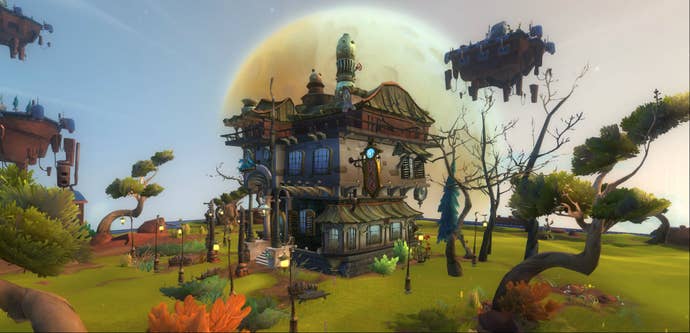
Did I say housing plots? Yeah, I did. At level 15, you get your own floating plot of land in the sky. You can customize it with items and recipes your find during your adventures or purchase on the auction house. The customization here is pretty robust. There's a number of different areas like houses, picnics, ponds, gardens, or forests you can add to your housing plot, and within those areas you can drop more cosmetic items. For some, questing to get stuff to fill up their housing plot will be their entire focus. For me, it was like Minecraft; I had big dreams upon seeing all the tools available, but when it came time to get in there and make something, I put a few things down and called it a day. You can also open your housing creations to your friends, allowing them to witness the splendor or squalor you've created.
WildStar is just so goddamn full of stuff. Cosmetic armor system so you can look however you want? It's here. Crazy mounts? Check. Crafting and harvesting are in the game, offering nine disciplines: Weaponsmith, Armorer, Mining, Outfitter, Survivalist, Technologist, Architect, Relic Hunter, and Tailor. Not jiving with the dungeons and raids? Why not try Adventures: smaller PVE experiences with choose-your-own-adventure options, weird gameplay mechanics, and a bit of replayability? Or, or, or...
There's just so much in WildStar and it's rather impressive for a game that just launched. MMOs have been getting better and better at this launch thing; Final Fantasy XIV: A Realm Reborn seemed rather feature-complete at launch, but honestly WildStar outdoes it. There's just so much to do in the game and it's all pretty fun on it's own, even if it doesn't always come together into a cohesive whole. Sometimes I found my myself looking at everything I could do and just shutting down mentally.
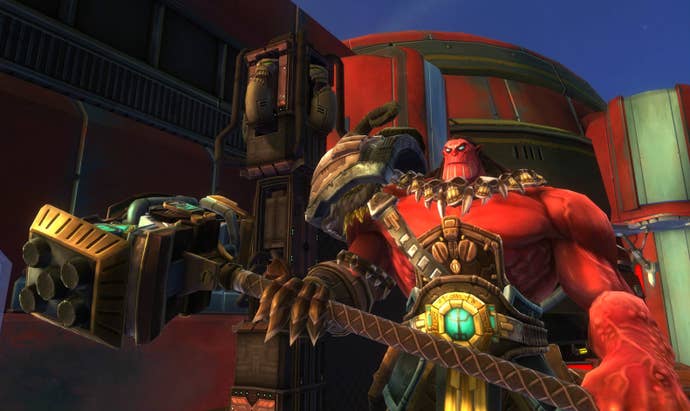
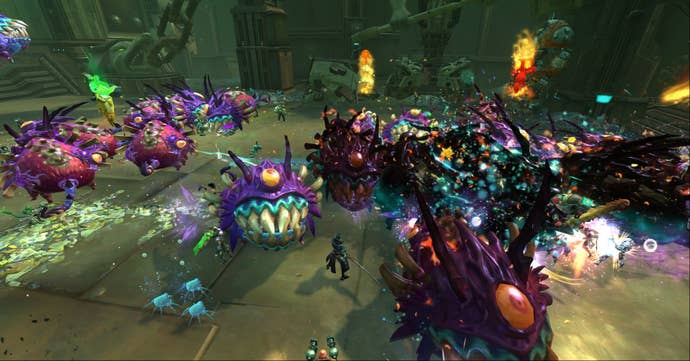

And all these features are wrapped in a bright, animated Pixar-style aesthetic. All the characters have exaggerated cartoon bodies and distinct silhouettes. The character animation for emotes is top-notch. I do wish all the female player models didn't stick to the Jessica Rabbit school of design - Granok women should be as burly as the men - but it's small thing that bothers me in a game that gets a lot of other stuff right.
The planet of Nexus is vibrant, with areas like Everstar Grove, Farside, and Grimvault all looking wildly different. Alien flora and fauna twist and animate, rolling hills give way to floating mountains of crystal, and frozen wastelands hide ancient secrets. Overall, there's just a sense of fun in WildStar's design that mirrors some of the best work Blizzard has come up with in World of Warcraft. In Final Fantasy XIV and Elder Scrolls Online, there's certainly a display of craft in the worlds their respective developers have created, but Blizzard and Carbine make me feel like they actually have a ton of fun creating these zones.
Hell, I'm sure Carbine had a ton of fun creating this game. Is WildStar perfect? No, but it's one of the best launch MMOs I've seen and Carbine has already updated it with a new content patch this month. Combat keeps your attention, dungeons aren't anything to sneeze at, housing and crafting give you something to do in your off-hours, and Paths are probably the best addition to MMOs since public quests. I can't tell you if I'll remain subscribed to WildStar a year from now, but currently the game is doing a good job of taking up my free time. I'd say that's a pretty good recommendation, despite those painful first ten levels.
VisualsEverything is colorful and well-animated, as WildStar avoids the more serious aethestics of many MMORPGs.
SoundThe soundtrack by Jeff Kurtenacker is simply flippin' amazing. One of the few MMO soundtracks I haven't just turned off for my Spotify playlist. Seriously, it's worth a <a href="https://soundcloud.com/inhisgroove">listen</a>!
InterfaceThe interface is utilitarian, but if you don't like it, there are a ton of mods out there to fix it.
Lasting AppealOnce you've gotten to level cap, there's still housing, crafting, raids, and new content patches to complete. Wildstar will keep you occupied for a while.
ConclusionIt's slow to start, but when WildStar finally kicks into high gear it throws a ton of content at you. Telegraphs make combat interesting and complex, some of the classes provide unique play experiences, and the Path system adds flavor to your overall quest. PVE, PVP, Housing, Crafting, Dunegeons, and Raids; if you want to do it, it's probably in here somewhere. Wildstar isn't perfect, but it's a great launch for an MMORPG.


